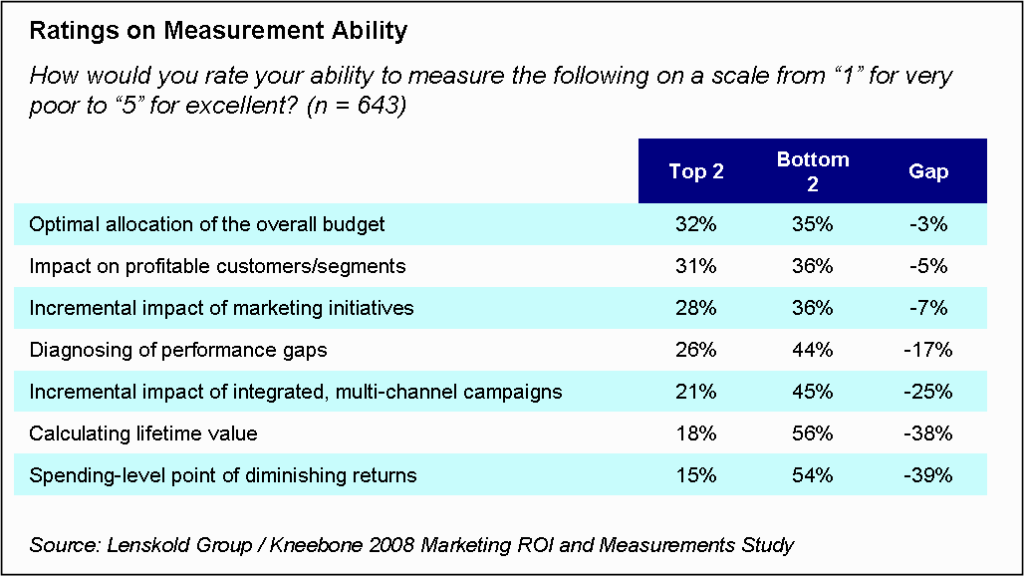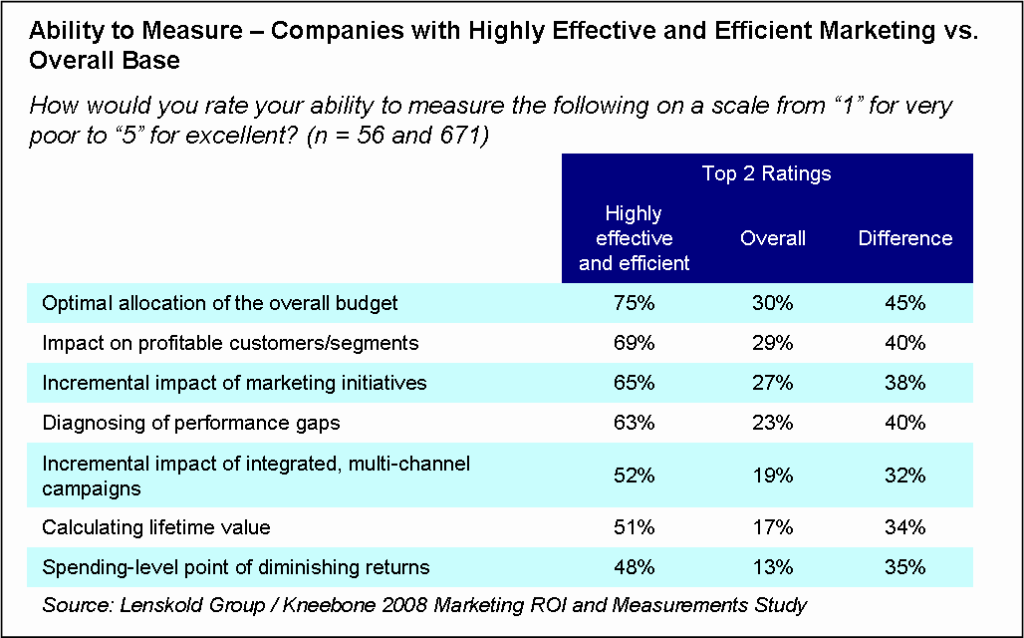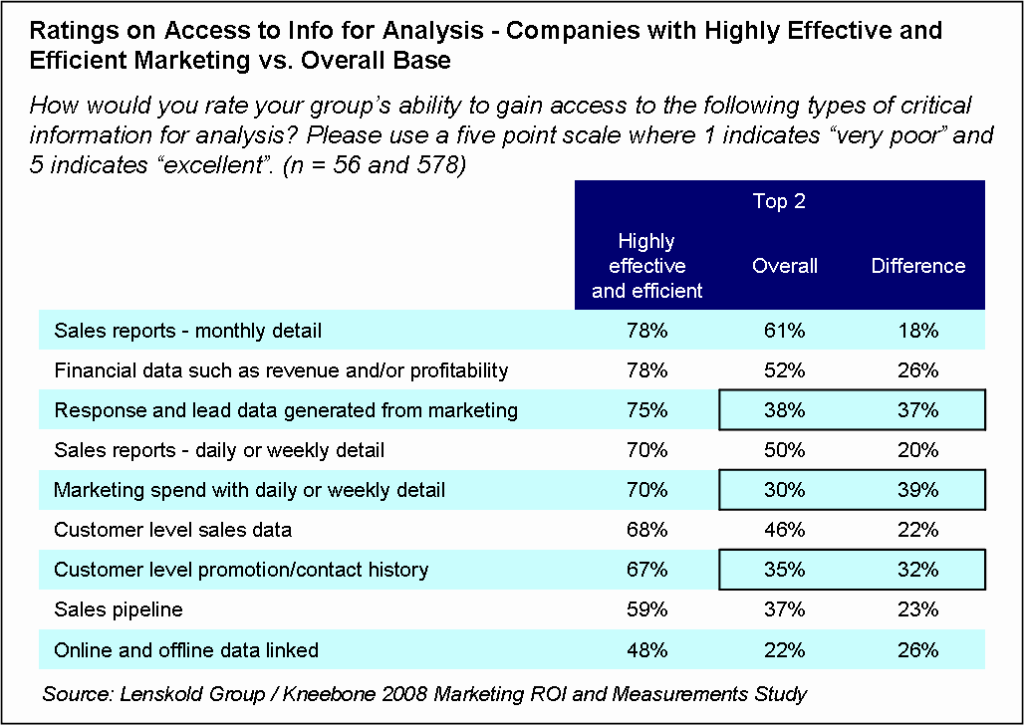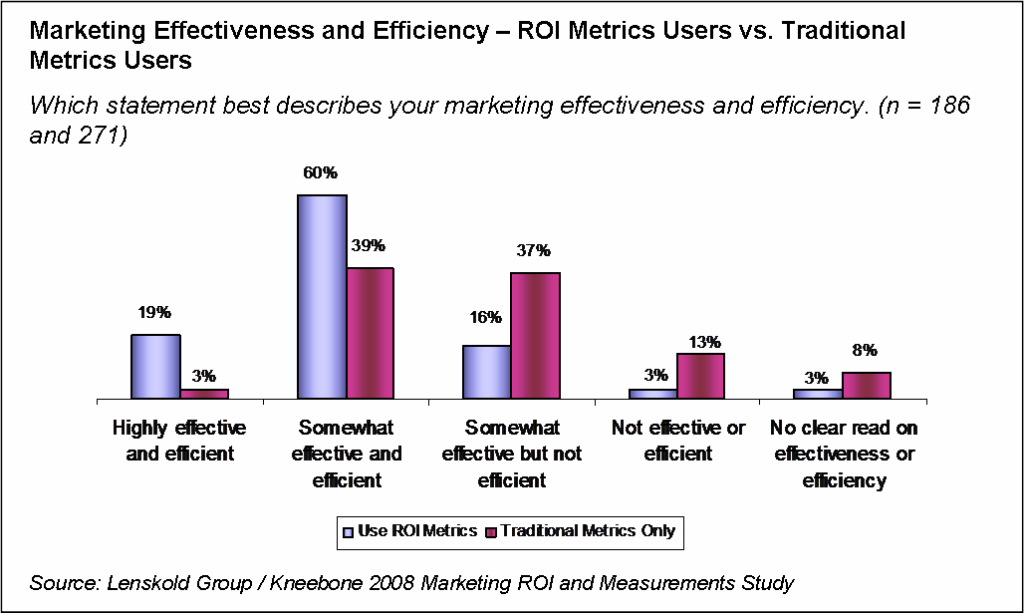Lenskold Article Series
by Jim Lenskold
2008 Survey Shows Better Data, Measurement Abilities, and ROI Metrics Boost Marketing Performance
Want to take your performance to that ideal level of highly effective and efficient marketing? It takes better access to detailed data and ROI discipline but it also comes along with greater growth and better levels of budgets, according to the Lenskold Group / Kneebone 2008 Marketing ROI and Measurements Study.
The study, conducted with 834 MarketingProfs members in April 2008, found that most marketers (75%) are making progress in diverse areas of marketing ROI and measurement capabilities, but many continue to struggle with some basic measurements that are required to manage and improve marketing’s contribution to business objectives. Overall, more marketers rated their measurement abilities as negative than positive as shown in Figure 1. The ability to measure the incremental impact of marketing and to diagnose performance gaps are particularly important to provide critical insight that can guide performance improvements.
Figure 1

Marketers who described their marketing as highly effective and efficient (just 9% of all marketers surveyed), showed better measurement and ROI practices, indicating that they are making marketing decisions with better insight. These high performers are:
- Much stronger in their measurement abilities (see Figure 2)
- Gaining access to critical data for analysis (see Figure 3)
- Much more likely to use ROI and profitability metrics to assess their marketing performance (see Figure 4)
These characteristics are helping companies to secure the right level of marketing budget to achieve their goals and to outgrow their competitors.
Measurement Abilities
Companies with highly effective and efficient marketing show much greater levels of measurement abilities, with roughly half to three-quarters providing positive ratings on their abilities – which is two to three times the levels reported from the overall base of marketers (see Figure 2). The ability to assess marketing performance and optimize the allocation of their marketing budget clearly enables these companies to manage and deliver more effective and efficient marketing.
Figure 2

Access to Data for Analyses
What critical information would you think marketing has the most difficult time getting for analysis? Maybe financial or sales data? Believe it or not, the greatest challenge is getting information that is generally controlled by the marketing organization. As shown in Figure 4, the lowest ratings on the ability to access information were for marketing spend data, promotion/contact history, and response/lead data. While marketers typically manage this information, the real challenge is the ability to get detailed information that is consolidated and available for analysis.
Looking at the same chart, you can also see that companies with highly effective and efficient marketing show no gaps in these same areas of data access, suggesting an advantage over other companies. There is clearly a need for marketing organizations to step up their level of automation to capture this critical data, apply analyses, and drive higher performance.
Figure 3

Marketing ROI and Profitability Metrics
There is a strong correlation between marketing effectiveness and efficiency and the use of marketing ROI and profitability metrics to assess marketing performance. When looking at how users of marketing ROI metrics describe their effectiveness and efficiency, a combined 79% indicate they are highly or somewhat effective and efficient (vs. 42% of those using just traditional, non-financial marketing metrics) and 19% indicate they are highly effective and efficient (vs. 3% of those using just traditional marketing metrics). Just 19% of ROI metrics users reported that their marketing was not efficient compared to 50% of those using traditional metrics. Effectiveness can be judged in many ways but to achieve success in both effectiveness and efficiency clearly requires the use of financial metrics such as ROI.
Figure 3

Greater Growth and Sufficient Budgets
In addition to having higher effectiveness and efficiency, companies using marketing ROI and profitability metrics are more likely to be outgrowing their competitors (64% vs. 47% of those using traditional marketing metrics.
More then half (52%) of the general base of marketers report that their budget is below the level necessary to achieve their goals. But as you might expect, those companies with highly effective and efficient marketing – who are also more likely to use ROI and profitability metrics, have better access to data, and have better measurement abilities – indicate they have sufficient or higher budgets available (63% vs. 39% overall).
The challenge is making your case to get the resources and support for better data access, measurements, and metrics. It is clear that better insight increases marketing and business performance. And it is obvious that better measurements of marketing impact and contribution will improve credibility and help secure better budgets. But breaking the barriers of existing practices is not easy. It takes leadership with a commitment to the discipline of measurements and ROI to take the first step of investing to get actionable insight and then using the success in performance improvements to make a lasting shift the culture and practices of the marketing organization.
The 2008 Marketing ROI and Measurements research report offers more findings, additional detail, and recommendations. The report is available for download: 2008 Marketing ROI and Measurements Study.


